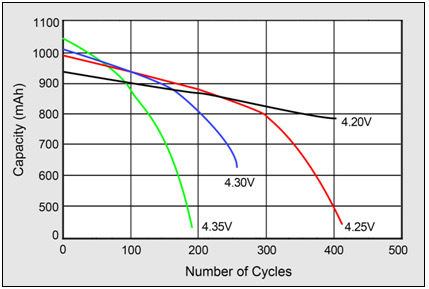cycle life
The cycle life is the number of discharge-charge cycles that a battery can tolerate under specified conditions before it fails to meet specified criteria as to performance (e.g., capacity decreases to 80-percent of the nominal capacity).

A charge cycle life is the process of charging a rechargeable battery and discharging it as required into a load. The term is typically used to specify a battery’s expected life, as the number of charge cycles affects life more than the mere passage of time. Discharging the battery fully before recharging may be called “deep discharge”; partially discharging then recharging may be called “shallow discharge”.
In general, number of cycles for a rechargeable battery indicates how many times it can undergo the process of complete charging and discharging until failure or it starting to lose capacity.[1][2][3][4]
Apple Inc. clarifies that a charge cycle means using all the battery’s capacity, but not necessarily by full charge and discharge; e.g., using half the charge of a fully charged battery, charging it, and then using the same amount of charge again count as a single charge cycle.[5]
See also[edit]
References[edit]
- Jump up^ Tony Bove (2 February 2010). iPod & iTunes For Dummies, Book + DVD Bundle. John Wiley & Sons. p. 26. ISBN 978-0-470-59070-6. Retrieved 19 June 2013.
- Jump up^ G. S. George (1 January 2007). Applied Science II. Technical Publications. p. 8. ISBN 978-81-8431-146-4. Retrieved 19 June 2013.
- Jump up^ United Nations (2009). Recommendations on the Transport of Dangerous Goods: Manual of Tests and Criteria. United Nations Publications. p. 394. ISBN 978-92-1-139135-0. Retrieved 19 June 2013.
- Jump up^ Davide Andrea (2010). Battery Management Systems for Large Lithium Ion Battery Packs. Artech House. p. 189. ISBN 978-1-60807-105-0. Retrieved 19 June 2013.
- Jump up^ Apple: Lithium-ion Batteries